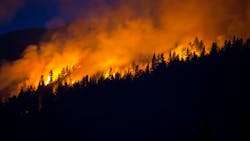How to Build and Maintain Fire-Resistant Facilities
Key Highlights
- Use fire-resistant building materials such as cement, stucco, masonry, or treated wood to improve fire resistance and reduce combustibility.
- Divide your landscape into three zones around the building, keeping the immediate 5 feet clear of combustibles and managing vegetation up to 100 feet away.
- Maintain regular grounds upkeep by removing dead trees, branches, and weeds to create defensible space and reduce fire fuel sources.
- Install ember-resistant vents and seal gaps at doors and windows to prevent embers from entering and igniting interior spaces.
- Consider zeroscaping with drought-tolerant, low-flammability plants and decorative stones to minimize water use and fire risk.
Whether or not your building is in a wildfire-prone area, the risk of fire affects every facility. Fortunately, most buildings can be hardened against fire in some way. Consider these strategies to increase your building’s fire resilience.
Fire-Resistant Building Materials
Building components and materials are evaluated on two categories when it comes to fire protection, explained Eric Roeder, national engineering practice leader, fire protection, for HGA.
- Fire resistance: The ability to resist the passage of fire and heat.
- Combustibility: The ability for the material to catch fire and for fire to spread on its surface.
These may sound like the same thing, but they’re not. Roeder names a steel facade on the outside of a building as an example. “You’re not going to be able to light the steel on fire. It’s not going to spread the fire along the surface,” Roeder said. “But, it doesn’t do much for the fire resistance. You would still be able to tell that on the other side of that thin metal layer, there’s something hot, and that heat is passing through.”
Heavy timber construction, which is making inroads in architecture, is another prime example. Wood is combustible and the fire will spread, Roeder explained, but at a certain point, the fire stops spreading because there is no more fuel available due to the char layer that develops on the thick timber. “These two elements in combination are really what you want to look for if you want to improve the fire resistance of your building,” Roeder said. “You either want to increase the fire resistance of the assemblies from which your building is built, or you want to decrease the combustibility of the exposed surfaces.”
Non-combustible exterior materials include cement, plaster, stucco, and masonry, Roeder noted. Wood treated with fire retardant substances can also qualify. The California Building Code offers many options developed to account for wildfire risk; even if you don’t live in an area prone to wildfires, it can be a helpful resource for hardening buildings against fire.
Landscaping Strategies to Stop or Delay Fire Spread
Your grounds and landscaping also play a critical role in preventing fires from spreading, said Daniel Spilman, senior project architect for HGA. You’ll essentially divide your site into three zones.
Zone 1: The 5 Feet Immediately Surrounding Your Building
This zone should be kept free of combustibles as much as possible. “We’re going to look to keep that clear of tall grasses, any large trees, and flammable trees of certain species—like evergreens—that spread fire quickly,” Spilman said.
Zone 2: 5 Feet to 30 Feet from Your Building
“From 5 to 30 feet, if you still want to maintain a landscape, you can do so safely,” Roeder said. “What you want to do is be thoughtful about the way fire transfers from object to object. If you have trees, you don’t want your trees to be too close together. You don’t want a large density of combustible material, because with more fuel, you have a larger fire.”
Keep trees spread out and eliminate ladder fuel—low-hanging shrubs and ground cover that can allow fires to traverse from the ground into a tree’s canopy, Roeder suggested.
Zone 3: 30 Feet to 100 Feet from Your Building
The risks are lower in this zone because of the distance from your building, but you still need to be mindful of risks, Roeder said. “You still want to make sure you’re not creating an overgrown environment where the fire can grow to an unsustainable size,” Roeder said. “An unmaintainable environment would still put the building at risk even at 100 feet.”
In Every Zone
The entire grounds need to be maintained regularly, Spilman said. Clear dead trees, branches, and weeds so that you’re maintaining defensible space.
Some building owners take it a step further and adopt a zeroscaping landscape strategy. Often mistaken for xeriscaping—the use of native and drought-tolerant plants, but in a way that’s more aesthetically pleasing—zeroscaping is about reducing water needs to the absolute minimum. It often incorporates the use of gravel, rocks, and decorative stones, in addition to minimal plantings that are able to thrive in arid conditions. Zeroscaping can also reduce the risk of fire.
Additional Fire Resilience Strategies
Buildings without ember-proof vents are at risk of an interior fire, noted Tryggvi Thorsteinsson, cofounder of the Santa Monica-based architecture and construction studios Minarc and ERLA Construction. “If embers get in there, anything that can catch on fire will catch on fire,” Thorsteinsson noted.
“Make sure the eaves are completely closed and sealed and any vents allowing air into the eaves, attic space, or underside of any building [use] vents specifically made for this purpose,” Spilman said. “Replacing any under-soffit or under-eave vents with ember-resistant vents is a huge thing that can prevent fires in a building.”
Doors and windows are another potential trouble spot, Spilman said. Make sure there aren’t gaps at the bottom of doors where embers can enter.
The most important thing is to start by assessing your property, Thorsteinsson added. Start today and look for obvious risk factors where you might need to replace materials or repair gaps that embers can get through. Examine your grounds and determine how they can be made more fire-resistant.
“Strategies and upgrades to increase the longevity of the building in general, not just against fire, are going to be more robust against any type of exterior environment or the elements in general,” Spilman said. “Upgrading doors, windows, and vents—those things are not only going to reduce the risk of endangerment by fire, but also reduce energy impacts and increase the longevity of the building.”
About the Author
Janelle Penny
Editor-in-Chief at BUILDINGS
Janelle Penny has been with BUILDINGS since 2010. She is a two-time FOLIO: Eddie award winner who aims to deliver practical, actionable content for building owners and facilities professionals.


